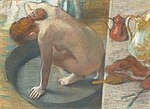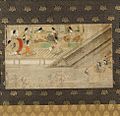Fukinuki yatai (吹抜屋台) describes a feature of Japanese art particularly associated with e-maki (絵巻) painted scrolls, famously for example, yamato-e. Literally...
3 KB (268 words) - 22:13, 15 August 2020
even the removal of the roofs to represent the interior of buildings (fukinuki yatai). A second notable example of the onna-e paintings in the Heian period...
137 KB (15,556 words) - 13:27, 21 April 2024
average women in their day to day life. The Japanese technique known as fukinuki yatai, or “blown off roof,” allows the viewer to see into the interior of...
2 KB (154 words) - 17:02, 15 April 2024
Emaki is characterized by two pictorial techniques: fukinuki yatai and hikime kagibana. Fukinuki yatai ("blown-off roof") refers to a form of composition...
12 KB (1,703 words) - 12:42, 2 May 2024
drawn again or enhanced in ink to accentuate the depth. The so-called fukinuki yatai technique, involving the removal of building roofs, was used to depict...
13 KB (1,476 words) - 19:28, 7 April 2023
interior scenes, the painter did not use the classical technique of fukinuki yatai, consisting of removing the roof to show the parts of a building from...
11 KB (1,116 words) - 09:24, 19 June 2023
constraints of court life. Like most emaki, the composition is based on the fukinuki yatai ("blown-off roof") technique, which consists of a perspective of looking...
64 KB (7,386 words) - 02:08, 11 January 2024
of a Buddhist memorial service in blown away roof technique (吹抜屋台, fukinuki yatai) 1100late Heian period One handscroll, ink on paper decorated with gold...
132 KB (5,257 words) - 09:39, 22 April 2024







